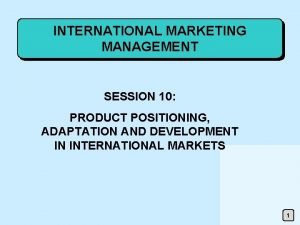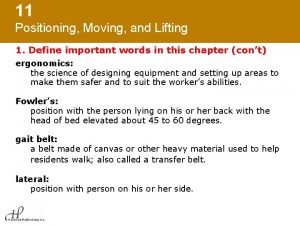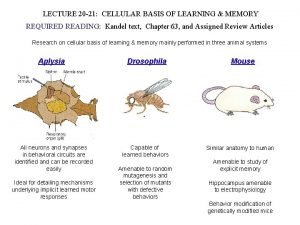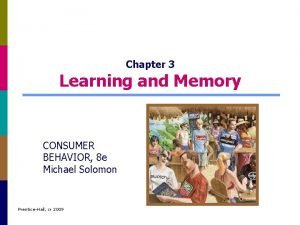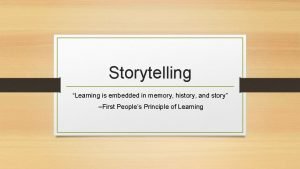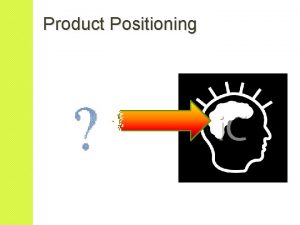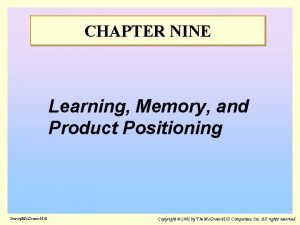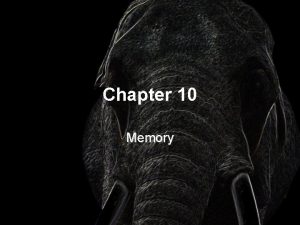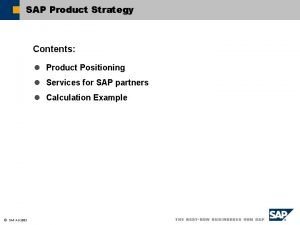CHAPTER 9 LEARNING MEMORY AND PRODUCT POSITIONING 9



























- Slides: 27

CHAPTER 9 LEARNING, MEMORY, AND PRODUCT POSITIONING 9 -1

Consumer Behavior In The News… Can they really do that? Ø Hershey’s, long known for its great candy bars, has extended into cookies. Ø In fact, they have gone so far as to use the Hershey name on the cookie. Ø Is this a smart move for the Hershey brand? Ø Why? Source: S. Thompson, “Hershey gets into cookie jar, ” Advertising Age, November 1, 2004, p. 6. 9 -2

Consumer Behavior In The News… Can they really do that? Ø Is this a smart move for the Hershey brand? Ø More than likely, yes. Ø Why? Ø Hershey’s Cookies LEVERAGES the strong Hershey name. Ø It does so in a category for which there is a strong fit on factors such as taste and quality. Source: S. Thompson, “Hershey gets into cookie jar, ” Advertising Age, November 1, 2004, p. 6. 9 -3

The Nature of Learning and Memory 9 -4

Memory’s Role in Learning Memory consists of two interrelated components: components 1. Short-term Memory (STM) a. k. a. working memory • is that portion of total memory that is currently activated or in use. 2. Long-term Memory (LTM) • is that portion of total memory devoted to permanent information storage. • Semantic memory is the basic knowledge and feelings an individual has about a concept. • Episodic memory is the memory of a sequence of events in which a person participated. 9 -5

Memory’s Role in Learning Short-Term Memory Ø STM is Short Lived • Consumers must constantly refresh information through maintenance rehearsal or it will be lost. Ø STM has Limited Capacity • Consumers can only hold so much information in current memory. Ø Elaborative Activities Occur in STM • Elaborative activities serve to redefine or add new elements to memory and can involve both concepts and imagery 9 -6

Memory’s Role in Learning Long-Term Memory Ø Schemas (a. k. a. schematic memory) Ø Scripts Ø Retrieval from LTM 9 -7

Memory’s Role in Learning A Partial Schematic Memory for Mountain Dew 9 -8

Learning Under High and Low Involvement 9 -9

Learning Under High and Low Involvement Classical Conditioning Classical conditioning is the process of using an established relationship between one stimulus (music) and response (pleasant feelings) to bring about the learning of the same response (pleasant feelings) to a different stimulus (the brand). 9 -10

Learning Under High and Low Involvement Operant Conditioning Operant conditioning (or instrumental learning) involves rewarding desirable behaviors such as brand purchases with a positive outcome that serves to reinforce the behavior. 9 -11

Learning Under High and Low Involvement Shaping Can Be Used in Operant Conditioning 9 -12

Learning Under High and Low Involvement Cognitive Learning 1. Iconic Rote Learning 2. Vicarious Learning/Modeling 3. Analytical Reasoning 9 -13

Learning Under High and Low Involvement 9 -14

Learning, Memory, and Retrieval Marketers want consumers to learn and remember positive features, feelings, and behaviors associated with their brands. What happens when consumers forget? Conditioned Learning Cognitive Learning Extinction Desired response decays or dies out if not reinforced. Retrieval Failure Information that is available in LTM cannot be retrieved. 9 -15

Learning, Memory, and Retrieval Forgetting over Time: Magazine Advertisement Source: LAP Report #5260. 1 (New York: Weeks Mc. Graw-Hill, undated). Reprinted with permission from Mc. Graw-Hill Companies, Inc. 9 -16

Learning, Memory, and Retrieval Ø Strength of Learning Ø Memory Interference Ø Response Environment 9 -17

Learning, Memory, and Retrieval Strength of Learning Strength of learning is enhanced by six factors: 1. Importance 2. Message Involvement 3. Mood 4. Reinforcement 5. Repetition 6. Dual Coding 9 -18

Learning, Memory, and Retrieval Impact of Repetition on Brand Awareness for High- and Low-Awareness Brands Source: A Study of the effectiveness of Advertising Frequency in Magazines, 1993 Time, Inc. Reprinted by permission. 9 -19

Learning, Memory, and Retrieval Repetition Timing and Advertising Recall Source: Reprinted from H. J. Zielski, “The Remembering and Forgetting of Advertising, ” Journal of Marketing, January 1959, p. 240, with permission from The American Marketing Association. The actual data and a refined analysis were presented in J. L. Simon, “What Do Zielski’s Data Really Show about Pulsing? ” Journal of Marketing Research, August 1979, pp. 415 -20. 9 -20

Learning, Memory, and Retrieval Memory interference occurs when consumers have difficulty retrieving a specific piece of information because other related information in memory gets in the way. A common form of interference in marketing is due to competitive advertising. Competitive advertising makes it harder for consumers to recall any given advertisement and its contents. 9 -21

Learning, Memory, and Retrieval What Can Marketers Do to Decrease Competitive Interference? Avoid Competing Advertising Strengthen Initial learning Reduce Similarity to Competing Ads Provide External Retrieval Cues 9 -22

Brand Image and Product Positioning Brand image refers to the schematic memory of a brand. Perceived Product Attributes Manufacturer Marketer Characteristics Benefits Brand Image Users Usage Situations 9 -23

Brand Image and Product Positioning Product positioning is a decision by a marketer to try to achieve a defined brand image relative to competition within a market segment. An important component of brand image is the appropriate usage situations for the product or brand. Perceptual mapping offers marketing managers a useful technique for measuring and developing a product’s position. 9 -24

Brand Image and Product Positioning Perceptual Map for Automobiles 9 -25

Brand Image and Product Positioning Product repositioning refers to a deliberate decision to significantly alter the way the market views a product. This can involve Ø level of performance Ø the feelings it evokes Ø the situations in which it should be used, or Ø who uses the product 9 -26

Brand Equity and Brand Leverage Brand equity is the value consumers assign to a brand above and beyond the functional characteristics of the product. Brand leverage, leverage often termed family branding, brand extensions, or umbrella branding, branding refers to marketers capitalizing on brand equity by using an existing brand name for new products. 9 -27
 Internal memory and external memory
Internal memory and external memory Primary memory and secondary memory
Primary memory and secondary memory Virtual memory
Virtual memory Clean edge razor
Clean edge razor Positioning by cultural symbols examples
Positioning by cultural symbols examples International positioning strategies
International positioning strategies Cuadro comparativo e-learning m-learning b-learning
Cuadro comparativo e-learning m-learning b-learning Rocky slowly got up from the mat
Rocky slowly got up from the mat Difference between implicit and explicit memory
Difference between implicit and explicit memory Long term memory vs short term memory
Long term memory vs short term memory Logical versus physical address space
Logical versus physical address space Which memory is the actual working memory?
Which memory is the actual working memory? Virtual memory in memory hierarchy consists of
Virtual memory in memory hierarchy consists of Eidetic memory vs iconic memory
Eidetic memory vs iconic memory Shared memory vs distributed memory
Shared memory vs distributed memory Chapter 10 positioning transfers and ambulation
Chapter 10 positioning transfers and ambulation Positioning moving and lifting
Positioning moving and lifting Chapter 7 segmentation targeting and positioning
Chapter 7 segmentation targeting and positioning Cellular bases of learning and memory
Cellular bases of learning and memory Consumer behavior learning
Consumer behavior learning Wraml subtests
Wraml subtests Learning is embedded in memory history and story
Learning is embedded in memory history and story Product life cycle kotler
Product life cycle kotler Average product of labor
Average product of labor Depth of product mix
Depth of product mix What is industry/target market feasibility analysis
What is industry/target market feasibility analysis What is gnp and gdp
What is gnp and gdp Correlational points of parity examples
Correlational points of parity examples





